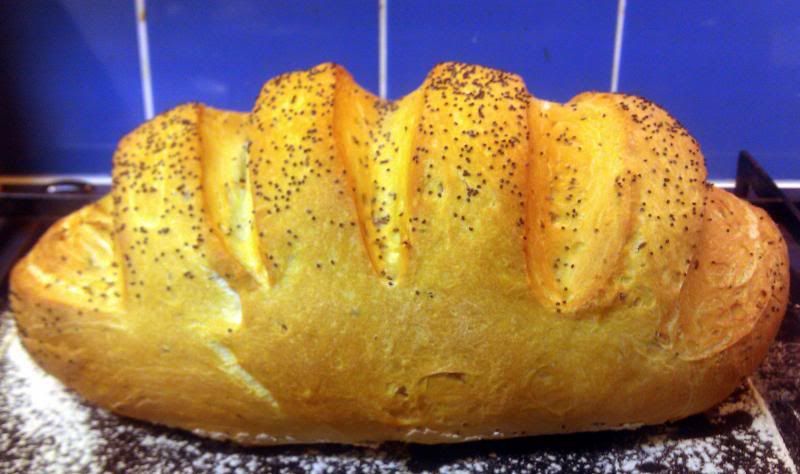http://modern-baking.com/bread_pastry/mb_imp_16706/
http://www.cookingforengineers.com/arti ... onstructed (Thank you for the link, DiggingDogFarm)
It is fully possible that the baking properties would benefit even more with sourdough, but I prefer baguettes with a 'fresh' taste. Please excuse me if the instructions are over-pedagogical. They were originally written for publication elsewhere.
Please note that the baguettes take eight hours to make, but the time can be split over two days.
Recipe for three baguettes of 35-40 cm in length
470 g wheat flour with high protein content (>11 %)
330 g cold water (around 10 deg C)
30 g cold water (around 10 deg C)
8 g salt (preferably sea salt)
4 g fresh yeast
Recommended equipment
Digital gram scale
Mixing machine
Baguette tray (mine is 38 cm long and has room for three baguettes. The amounts in this recipe are adapted to that tray).
Metal dough scraper
Razor blade or scalpel
Spray bottle with water
The instructions are in the captions below.

Mix the flour and 330 grams of water for only 1-2 minutes in the machine on slow speed, or until barely mixed. Cover and let stand for ½-1 hour. (The picture shows before mixing)

Add salt to the dough. Dissolve the yeast in 30 grams of water. Add to the dough (if the salt is added directly to the water and yeast, the yeast may die). Knead the dough in the machine on low speed for 2-3 minutes, or just until everything is thoroughly mixed. Don't knead for too long!

Transfer the dough onto the baking table.

At this stage, the dough looks more like a porridge or a thick batter.

Flatten the dough with floured hands. With a light hand, the dough won't stick.

With help of the floured scraper, fold the left side to the middle.

- then the right side.

- then the top and bottom. Flip so the seam faces the table. Let rise for 20 minutes. Repeat the folding, flipping and rising twice (that is three times in total).

The dough now has a smooth and elastic structure.

Cover with an upside-down large bowl (a towel is inexpedient since it sticks to the dough). Let rise until double in size (about three hours).

After the first rising.

Divide the dough in three loaves, roughly equal in size. Don't work the dough or change its shape! Let rest for 20 minutes to make the dough relax.

Now comes the tricky part. Shape the pieces into baguettes with the help of the scraper, without stretching the dough or changing its structure.

Work with a light hand and fast movements, so the dough doesn't stick. The loaves should be a little shorter than the tray.

Carefully transfer the loaves to the greased baguette tray and sift some flour on top. Let rise for another two hours, uncovered, or until they doubled or tripled in size. (Alternatively, they can be refrigerated and get their second rise later, within 24 hours)

After the second rising. They should be very well risen. Don't worry that they won't hold. If the instructions have been followed and the flour has ample protein, they will not collapse.

The oven should be 260 C. Provide steam, e.g. with boiling water in a pan. I also put a cork in the oven's funnel to keep the steam.

Make three incisions with a razor blade in the loaves and immediately move to the hot oven. The incisions should be shallow, only penetrating the outer dry crust that formed during the second rising. Reduce the temperature to 240 C and bake for 8 minutes, then reduce to 200 C, remove the water pan and bake for another 25 minutes. Baguettes must be thoroughly baked.

Spray the baguettes with a little cold water and let them cool without covering.

Don't cut in them until they have cooled completely. As seen in the picture, the porosity is almost perfect, with irregular bubbles and the crust is thin and crunchy. The baguettes will keep well for at least 24 hours. The best way to keep them is on the tray in room temperature, covered with a kitchen towel. Never put them into anything that is airtight, or the crust will immediately be spoiled!
Notes
* The quality and protein content of the flour is crucial. Ordinary wheat flour with 10 % protein can normally not be used. The protein content should be 11-13 percent. I use an excellent flour by the name of Manitoba Cream with 13 % protein.
* The yeast must be fresh baker's yeast. Dry yeast doesn't work well with cold water.
* Every ingredient should be exactly weighed.
* Gluten, which gives elasticity and structure to a dough, is normally produced by prolonged kneading. This gives a smooth end even texture which is convenient in factories and on store shelves, but that's not what we are after with baguettes. An artisan baguette should have an irregular structure, a thin crust and a delicate aroma of wheat. Therefore, baguette baking relies on another method to evoke gluten in the dough: autolyse and long fermentation by means of cold water together with a minimal amount of yeast. Thus it is important that the dough is given enough time to rise or it will collapse like a house of cards during the second rising. If the kitchen is hot, the dough should be moved to the refrigerator for a while so that it gets its total of six hours rising time.
* The water should be cold, but not ice cold. Directly from the tap is usually perfect (ca 10 C).
* It's probably possible to make well without a dough mixing machine, but it can be troublesome to knead such a loose dough.
* A special baguette tray to keep the shape is almost indispensable. The dough is so loose that it will float out if not supported on the sides.


